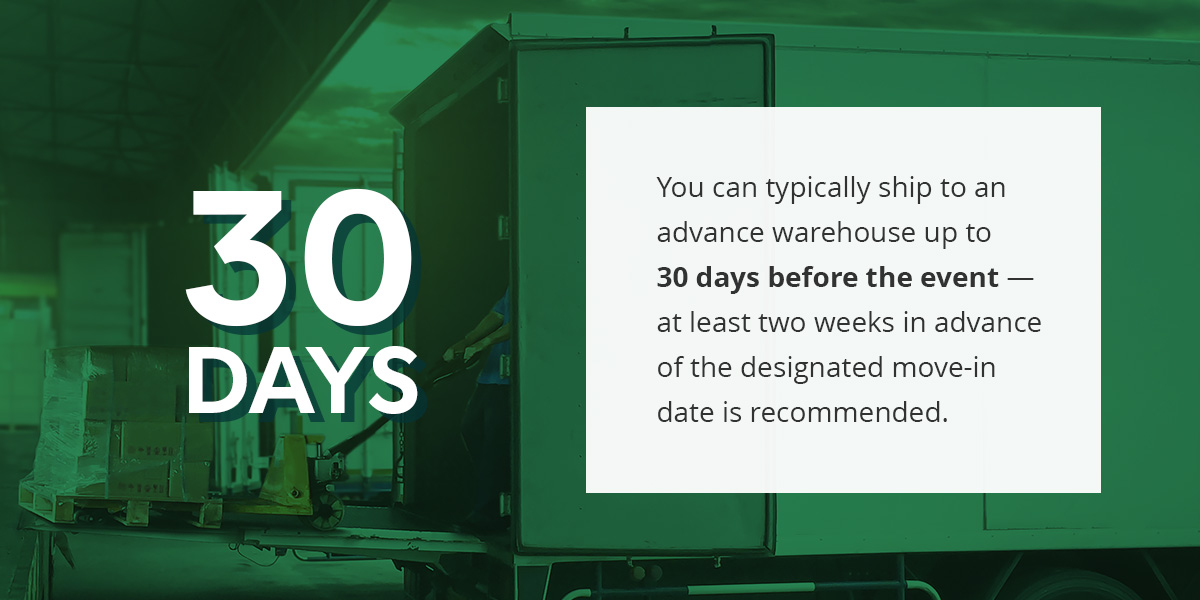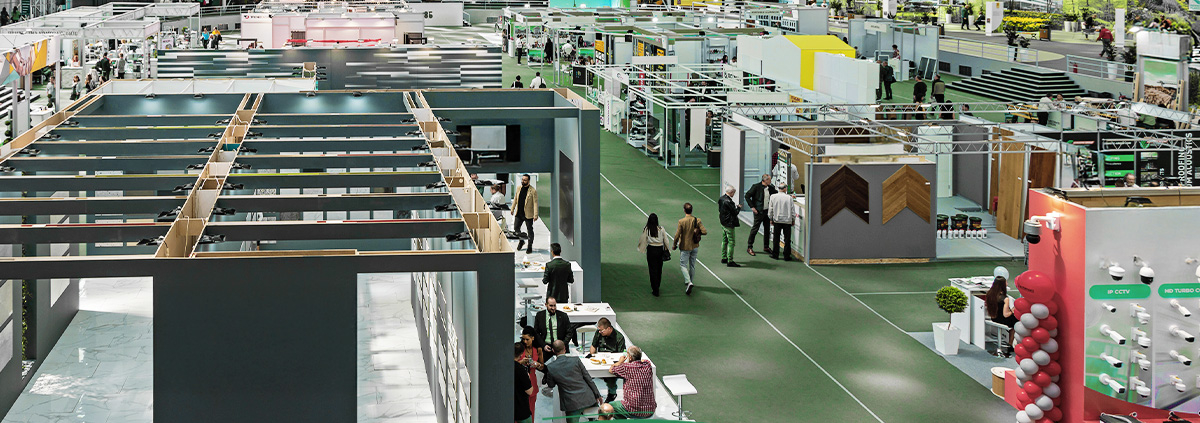Guide to Trade Show Shipping
A trade show presents an exciting opportunity to showcase your business’s products and services to a variety of industry professionals. These exhibitions are also an effective place to connect with peers and discover new trends.
However, a successful trade show experience takes more than simply showing up. Learn how to ship to a trade show below for a reliable, timely way to get your exhibits and supplies to your event.
How the Trade Show Shipping Process Works
Before you organize your brochures, samples, products, booth and other materials for shipping, understanding what to expect in the trade show shipping process is essential.
Advance Warehouse Storage vs. Direct-to-Show Shipping
There are two main options when shipping trade show exhibits and other materials — advance warehouse storage or direct-to-show shipping. With advanced warehouse storage, you ship your supplies to a warehouse near the trade show venue, typically a few weeks beforehand. If you ship directly to the show, your shipment will be delivered to a marshaling yard, which is a designated location for trucks carrying exhibitor freight or the venue itself.
If you want to avoid potential shipping delays and related stress, advance warehouse storage is a smart approach, but it also leaves you with less preparation time. In comparison, sending your shipment right to the venue means less risk of handling damage occurring from the warehouse to the venue and more time to put your shipment together. However, you will have less flexibility in the shipment timeline.
The 3 Stages of Trade Show Shipping
No matter which shipping option you choose, the process has three main parts:
- Start with inbound shipping: First, you will use inbound shipping to ship your exhibit and supplies to either a warehouse or the event’s location. A strategic shipping option, such as less-than-truckload (LTL) freight shipping, can help you save money and meet delivery deadlines. Depending on what you are shipping, you may be able to consolidate your shipment with others to reduce costs.
- Organize material handling/drayage: Next, your shipment will arrive. If you ship to a warehouse, the warehouse will store your freight and then transport it to the venue. If you shipped to the venue, your freight carrier will arrive at the venue’s marshaling yard at a specific time and drop off your freight on-site. In either case, you will need assistance to unload and move your supplies to your booth’s location — trade shows typically provide a general services contractor for material handling.
- End with outbound shipping: When the trade show is over, the same party that unloaded and moved your shipment to the show floor will transport it back to the venue’s loading dock. Finally, your logistics provider will pick it up and transport it to your next location, whether that is back to your business, a storage facility or another trade show.
Steps to Ship Your Trade Show Booth and Supplies
With a better idea of how to ship trade show supplies, you can take the right steps to prepare and ship your freight.
1. Review the Trade Show’s Shipping Guidelines
Before you decide to move forward with a specific shipping option, check in with a trade show representative to learn about their shipping requirements. Some common trade show shipping parameters include:
- Move-in and move-out dates: Many trade shows have instructions for moving freight in and out of the venue. It may have a universal move-in day for all attendees or use a targeted freight approach, where each booth space is assigned a specific delivery date and time. Consider the trade show’s rules for move-out, too.
- Freight guidelines: Certain venues may have restrictions for shipment contents. Check that your products and booth meet the provided requirements so you do not bring restricted materials into the building.
- Warehouse and shipping provider: The trade show may have an advanced warehouse where you can store your freight, so it could be helpful to look into that option prior to choosing your own warehouse. Additionally, they may advertise a preferred shipping provider. Keep in mind you are usually not required to use that provider.
2. Start Planning and Organizing

Once you are updated on the event’s shipping guidelines, you can start planning and organizing your shipment. As with any large professional event, it is important to prepare early. Give yourself and your team plenty of time to gather all your materials, locate a logistics partner, decide on a shipping method and address any small details that arise.
If you decide to ship to an advance warehouse, you can typically do so up to 30 days before the event — at least two weeks in advance of the designated move-in date is recommended. Otherwise, you can ship to the venue about a week ahead of move-in day. It may be helpful to connect with your logistics provider to discuss a shipment plan.
As you assemble your exhibit and materials, be aware of the freight class for a trade show booth and your entire shipment overall. The National Motor Freight Traffic Association sets freight classes, which play a role in shipment pricing. Most commonly, trade show freight is shipped under Class 125, though the specific classification depends on the shipment’s density, packaging and value.
3. Determine How You Will Transport Smaller Items
Given the range of materials you will likely bring to the trade show, you may need to explore more than one shipping option. While one shipping provider may be able to package smaller parcels with larger items during transport, another may not. If not, you can use alternate carriers to ship packages to your warehouse or the venue — note that additional package fees may apply depending on the carrier. Be sure to ship the items in a timely manner, so they arrive before or alongside the rest of your shipment.
How to Select a Trade Show Shipping Provider
Above all else, you will want a trusted shipping partner to transport and deliver your freight. However, a generic shipping carrier may not have the expertise you need — a company that knows how to ship a trade show booth and similar materials can help you navigate all the unique variables that come with trade show shipping. Here are a few qualities to look for to find the right provider:
- Experience: An experienced company will have the skills, knowledge and capabilities to meet your trade show shipping needs. Look for a shipping provider that is established in their field and strives to understand your goals and requirements. The right provider will also know the ins and outs of trade show shipping to provide high-level service.
- Varied shipping offerings: The ideal partner will be able to offer you various freight shipping options. LTL and full truckload (FTL) are two of the most common freight shipping solutions, and one may be more suitable for you based on your shipment type, budget and trade show schedule. Other options, such as van or flatbed shipping, may also be worth exploring.
- Additional logistics services: A shipping partner that also offers logistics services can be an effective asset to your company. For example, they may provide material handling services for your trade show freight or connect you with a local advance warehouse. With the right partner, you can access all the solutions you need from a single source.
- Clear communication: When shipping valuable items, transparent communication is crucial. A professional logistics provider will be proactive and responsive in updating you on the shipping process. Learn about their communication methods to determine whether they are a good fit.
Get a Quote From Green River Logistics Solutions Today
Whether you are a manufacturer preparing to exhibit a new product or a small business owner attending your first trade show, the logistics solutions you invest in can make a difference in your experience and success.
At Green River Logistics Solutions, we provide comprehensive trade show freight shipping to businesses in various industries. With a personalized approach, we will determine the most suitable and cost-effective option for your shipping needs — no matter if you are presenting at an international expo or a local event. Count on us to deliver complete transparency, flexibility and reliability throughout the entire process.
Learn more about our freight shipping and logistics solutions, and contact us for a free quote today.




